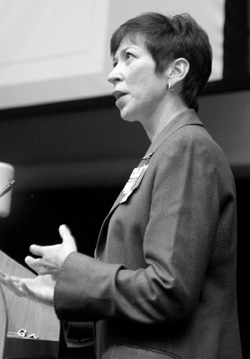
Marilyn Dubree outlined the State of Nursing at Vanderbilt during her presentation Tuesday afternoon in Light Hall. (photo by Dana Johnson)
VUMC working to be safest place in country
The Executive Safety Council was formed recently to help coordinate, augment and spread the many efforts of doctors, nurses, staff and administrators to prevent accidental death and injury from occurring at VUMC.
“Our goal is to make Vanderbilt the premier institution in the country when it comes to safety,” said Chief Medical Officer Dr. John Sergent, who chairs the council.
Three years ago the nation woke to a crisis in patient safety when a report from the Institute of Medicine highlighted studies suggesting that medical error was responsible for between 44,000 and 98,000 U.S. deaths per year. The authors of the report pointed out that the lower of these two estimates would make medical error the nation’s seventh leading cause of death, worse than the toll from motor vehicle accidents or breast cancer.
“For a hospital I think Vanderbilt is very safety-conscious and does a good job,” said Dr. Drew Gaffney, associate dean for Clinical Affairs and a member of the council. Health care, however, is on the primitive end of the safety scale, with standards that are lax compared to those of industries such as aviation and nuclear power. “There is no hospital in the world right now that the aviation industry would consider to be safe,” Gaffney said.
To help state the urgency of the problem of medical error, Gaffney makes a comparison between becoming a patient in the United States and being sent to fight in Iraq. Approximately one in 3,000 U.S. troops sent to Iraq has been killed in the war.
“A number of experts would put the accidental death rate in health care above that range,” Gaffney said. “Think of all the concern of friends, loved ones and countrymen for those who were put in harm’s way — we have a chance to address similar risk by creating safe systems in hospitals … We have a fantastic opportunity to prevent injury and death.”
Members of the council stress that safety is foremost a matter of design. It’s not enough that the doctors and nurses who work at VUMC are committed to safety and have based their lives on helping patients, because patient safety is more an aspect of systems than a result of individual intentions. When medical errors occur, analysis almost always shows a string of missed opportunities. “No accident is a single isolated point,” Gaffney said.
Sergent said quality assurance, with its reliance on setting acceptable parameters for adverse events such as post-op infection and unplanned hospital readmission, is no longer adequate as a method for promoting patient safety. “If airlines accepted a 1 percent crash rate none of us would fly,” Sergent said. “The problem with quality assurance is that it tends to make people complacent and doesn’t encourage improvement in the overall system of care.”
Continuous and comprehensive assessment of patient and plant safety will allow the council to respond to incidents, set priorities and develop new safety initiatives. While continuing to use data — integrating safety reports from some 40 VUMC departments and committees — the council will seek to raise the bar of performance across VUMC. The council is in a position to help different areas of VUMC learn from each other, and Vanderbilt through research and education is in a position to help lead the nation.
“I think Vanderbilt is uniquely poised to provide world-class leadership around this topic,” said council member John Bingham, director of the Center for Clinical Improvement. Two factors strongly in Vanderbilt’s favor are its leadership in the application of computers to clinical practice and a rare level of physician-hospital integration across both inpatient and outpatient areas.
A first set of initiatives currently under consideration by the council includes a safety education program for senior VUMC leadership, reformatting VUMC morbidity and mortality conferences to include root cause analysis and improvement processes, linking malpractice premium reduction incentives to safety programs and practices, implementing medical error prevention and risk management curricula for students and house staff, and decreasing practice variation in high-risk problem prone areas.
VUMC has already begun to borrow safety practices from other industries: on April 24, some 30 doctors and nurses participated in crew resource management training, used in the aviation industry to teach the importance of team communication in supporting safety. More of this training is planned.
With these and other initiatives under consideration, the council will seek to foster a new culture of safety at VUMC.
“We want a culture that is tolerant of error discussion and error reporting,” Sergent said.
“Blame doesn’t lead to improvement,” Gaffney said. “None of the people here intend to make a mistake; to me, blame is more appropriate with drugs or drinking, things outside the bounds.”
Joining Sergent, Gaffney and Bingham on the council are faculty members Drs. Robert Dittus, Jay Deshpande, Jerry Hickson, John Morris, Harvey Murff and Mary Yarbrough; Dr. Eric Grogan (house staff); Marilyn Dubree (Nursing); Dan France (Center for Clinical Improvement); Sandy Bledsoe and John McCauley (Risk and Insurance Management); Ken Browning (Plant Operations); and Susan Moseley (Accreditation and Standards). The council will work closely with the Medical Center Safety Committee (environment and plant safety), the Center for Improving Patient Safety (research oriented), and the Patient Safety and Risk Management Committee. The council is an arm of the VUMC Quality Council, which is in turn an arm of the Medical Center Medical Board. The council will be assisted by a new job position, VUMC patient safety director (the job was recently posted).













